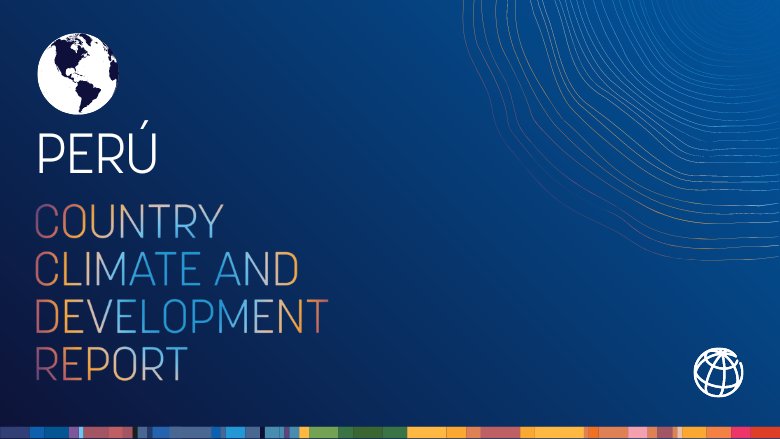LIMA, Nov. 3, 2022 – Climate action can increase Peru’s GDP by 2% by 2030 and 10% by 2050 and create millions of formal jobs, says the World Bank Group’s Country Climate and Development Report (CCDR) released today. Peru can benefit from decarbonization policies, leveraging its forests, clean electricity (over 60% renewable), fertile land and vast copper resources to be a leader in a global low-carbon transition. By controlling deforestation and decarbonizing transportation, Peru can drive growth through sustainable agricultural and copper exports, while bringing long-term development benefits to the population.
Climate change poses a significant threat to Peru's development and prosperity due to the country’s geography, persistent inequalities, and its natural resource-dependent economic structure. But Peru has opportunities and advantages to transition to a resilient, low-carbon development that will enable it to achieve higher growth and inclusive development.
The CCDR analyzes fundamental changes in the areas of energy, reforestation, transport, cities, water, and land use that would enable the country to move to a resilient, low-carbon and more productive economy by 2050. The report highlights the need for urgent action to adapt to climate change and to combat threats to its forests, a resource that can generate many local benefits and at the same time could become important to carbon markets in the coming decades.
"Decarbonization and the transition to a greener economy will increase resilience and prosperity for all Peruvians," said World Bank Vice President for Latin America and the Caribbean Carlos Felipe Jaramillo. "This report offers realistic ideas for high-impact climate action for Peru that support development and explore opportunities and reforms to enable private sector and community participation in the transition."
“Tackling climate change requires the mobilization of large sums of private capital. For this to happen, it is vital that Peru designs and implements the right policies and reforms,” said Alfonso García Mora, IFC Regional Vice President for Europe, Latin America and the Caribbean. “Promoting green growth in all sectors of the Peruvian economy is a clear priority,” he added.
Climate change risks and natural hazards have already exposed Peru to severe economic and welfare losses, threatening its inclusive development path. According to the report, natural disasters cause an average annual loss of 2% of GDP and welfare losses equivalent to 5.2% of GDP. In addition, changes in precipitation, accelerated glacial melting, and the increased frequency and severity of floods, landslides and droughts will have a significant impact on the availability of water for agriculture, human consumption and energy production, with considerable economic consequences.
Poor and vulnerable populations are already disproportionately affected by natural hazards, and without adaptation, climate change will slow poverty reduction even more. Low access to adequate housing, safe drinking water, quality public transport, sanitation, and other basic services, as well as a high level of informality, increase the vulnerability of the poor to climate change impacts, notably higher temperature, flooding, and landslides.
In this regard, the country can direct public investment towards key areas that would allow Peru to achieve green and inclusive development. Among them, the report recommends investing in water storage for multiple purposes (irrigation, consumption, energy generation), agricultural innovation systems, and social protection to help the poorest households respond to climate disasters.
World Bank Group Country Climate and Development Reports
***
The World Bank Group’s Country Climate and Development Reports (CCDRs) are new core diagnostic reports that integrate climate change and development considerations. They will help countries prioritize the most impactful actions that can reduce greenhouse gas (GHG) emissions and boost adaptation, while delivering on broader development goals. CCDRs build on data and rigorous research and identify main pathways to reduce GHG emissions and climate vulnerabilities, including the costs and challenges as well as benefits and opportunities from doing so. The reports suggest concrete, priority actions to support the low-carbon, resilient transition. As public documents, CCDRs aim to inform governments, citizens, the private sector and development partners and enable engagements with the development and climate agenda. CCDRs will feed into other core Bank Group diagnostics, country engagements and operations, and help attract funding and direct financing for high-impact climate action.
---
Note to journalists:
The Climate and Country Development Report (CCDR) prepared by the World Bank Group for Peru lists a number of opportunities and advantages that would allow the country to achieve green and inclusive development. In summary:
- Transforming the forestry sector into a carbon sink, significantly reducing deforestation and harnessing forest resources could create nearly 2.4 million jobs between 2023 and 2050 and increase the contribution of the forestry sector to the Peruvian economy sevenfold.
- Improving land use planning with agricultural innovation systems, promoting private investment, integrating small producers and community organizations in the highlands and jungle into agricultural value chains, and capitalizing on the successful productive experiences of the coast would improve the inclusive growth of the entire sector.
- Improving connectivity and access to irrigation and resilient transportation for the jungle and highlands would decrease people's vulnerability, reduce repair and maintenance costs, and accelerate growth in agriculture and forestry.
- Decarbonizing urban, passenger and freight transport through electrification in the medium term would enable Peru to reach zero emissions by 2050.
- By increasing government coordination, improving the efficiency of public spending and implementing comprehensive climate policies that take action on climate change, increase productivity and reduce poverty, the resulting productivity and efficiency gains could increase GDP by 2 % by 2030 and potentially much more by 2050
- Decarbonizing the mining sector with renewable energy, reducing water pollution and building community confidence would allow Peru to benefit from the expected demand for minerals such as copper, silver and zinc, which are strategic in the global transition and are expected to increase in value more than fourfold over the next two decades.

